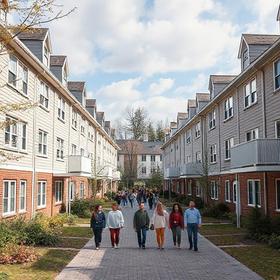Emerging Challenges for Boarding Schools in 2025
In 2025, boarding schools are navigating a complex landscape shaped by shifting demographics, financial pressures, evolving student needs, and heightened expectations from families and regulators. This article examines the major challenges confronting boarding schools today—as well as how institutions are responding—so that parents, students and educators can understand what’s at stake in this unique segment of education.
1. Escalating Costs and Tuition Pressures
One of the most visible and persistent challenges for boarding schools is the high and rising cost of tuition. According to data from Boarding School Review, full-board tuition at many U.S. boarding schools in 2025 ranges between $60,000 and $80,000 per year. Boarding School Review For example, some leading schools list tuition above $70,000 for the 2025 academic year.
These sticker prices present real affordability challenges for many families. Although generous financial aid programs exist (and some schools now cap tuition at 10 % of income for qualifying households), the headline cost remains a problem for recruitment, access and diversity.
For boarding schools, the cost challenge goes beyond tuition. Operating large residential campuses with dormitories, dining, health services, and extracurricular staffing means schools must manage high fixed costs. Even modest enrollment drops can have outsized impact on budgets. As independent school leaders have warned, rural or lower-enrollment boarding programmes are especially vulnerable.
Implications for families and educators:
Families considering boarding must account not only for tuition, but also travel, personal expenses, health insurance, technology and other “hidden” costs.
Schools must respond to cost concerns by enhancing transparency, expanding financial aid, and demonstrating value (academic, residential life, outcomes) to families.
For schools operating at a smaller scale or in less affluent markets, the cost structure may create sustainability risk if enrolments decline.
2. Shifting Enrollment and Market Dynamics
Boarding schools are experiencing significant change in enrollment dynamics—and these shifts present challenges and opportunities alike. A key data point: according to the National Association of Independent Schools (NAIS) Trendbook, between 2018-19 and 2022-23, boarding schools (defined as schools with 95 % or more boarding students) saw a 17 % decline in median enrolment, whereas day schools fared better. One estimate finds that 63 % of private boarding schools reported declining enrolment between 2019-20 and 2023-24.
At the same time, some schools are seeing growth in international student enrolment: about 45 % of NAIS-member boarding schools reported a year-on-year increase in international students in 2024-25—17 points higher than the increase at all independent schools. aisap.org Moreover, boarding schools report that international students now represent roughly 15 % of the U.S. boarding student population.
Key drivers and implications:
Domestic demand has softened: A combination of demographic headwinds (fewer families able/willing to pay full boarding tuition), changing family preferences (less appetite for full-residential life), and increased competition from day schools/hybrids has squeezed boarding enrolments.
International recruitment is now critical: Many boarding schools rely on tuition from boarding students (often including international students) to fill beds and maintain budget balance. Disruption or unpredictability in global recruitment (visa/regulatory issues, geopolitical trends, currency exchange) therefore pose risks.
Marketing and product differentiation matter more than ever: Schools that successfully articulate their value proposition—strong outcomes, distinct residential life, global diversity, innovative programmes—stand a better chance of stabilizing enrolments.
Resilience matters: Schools with larger endowments, more flexible admissions/aid models, and diversified programmes (day-/flex-board options) are better placed to weather enrolment fluctuations.
3. Student Well-being, Mental Health and Residential Life
Residential life at boarding schools offers many rich developmental opportunities, but it also raises unique well-being challenges that institutions must manage with care. In 2025, mental health continues to be a top concern. Many boarding schools report increased levels of anxiety, social isolation, homesickness, identity stress and adjustment issues among boarders.
Parents and educators alike are increasingly aware of the concept often referred to as “boarding-school syndrome” (though not a formal diagnosis): the idea that extended residential life away from home can have long-term emotional consequences if not managed well.
What boarding schools are doing (and still need to do):
Expanding counselling and wellness services on campus—24/7 residential staff trained in mental-health first response, peer-support programmes, dorm-life mentorship.
Embedding social-emotional learning (SEL) and life-skills education into the curriculum—e.g., time-management, conflict resolution, self-advocacy.
Strengthening home-school communication: regular updates, flexible visitation policies, hybrid day/board models for students who may benefit from a lighter residential load.
Proactive preparation: onboarding programs for new boarders (especially international students), cultural-adjustment training, dorm workshops on digital wellness and sleep hygiene.
For families, it means that fit is more important than ever. Not every student thrives in a full-residential environment—and boarding schools must clearly show how they support emotional wellbeing, belonging, peer community and transition.
4. Diversity, Equity & Inclusion (DEI) and Access
In recent years, many boarding schools have emphasized diversity of race/ethnicity, geography and socio-economic background. In 2025 the pressure is higher to demonstrate both access (affordability, financial aid) and belonging (inclusive residential life).
According to NAIS, in 2024-25 independent schools reported that 66 % of students were students of colour across day and boarding programmes. At boarding schools specifically, nearly 15 % of students are international. While this shows progress, families and educators continue to question the affordability barrier and whether stated DEI commitments translate into real change.
Critical issues for boarding schools:
Financial aid models: Schools that offer full-ride scholarship programmes or income-capped tuition (for example, some highly selective schools now cap tuition at 10 % of household income) are increasingly attractive to families seeking access. Boarding School Review
Residential culture and belonging: Inclusion in dorm life, cross-cultural dialogue, demographic representation among residential staff/teachers matter a great deal for student experience and retention.
Geographic diversity: With fewer boarders coming from local commuter markets, boarding schools must ensure that students from diverse geographies (including rural and international) are well supported.
Transparency and outcomes: Boards, families and accrediting bodies expect published data on financial aid, enrolment by race/ethnicity, student outcomes, retention in boarding. Schools that cannot or do not report risks reputational and recruitment costs.
5. Operational Complexity and Future-Ready Infrastructure
Maintaining a boarding campus is operationally complex: it involves academic programmes, residential life, food service, dorm maintenance, student safety, health services, personnel for evenings/weekends, and more. In 2025, new pressures include:
Facilities and sustainability: Boarding schools face significant cost to modernize infrastructure (residential halls, WiFi, climate control, safety systems) and meet sustainability goals. According to industry commentary, many independent schools are investing in “smart campus” technologies and green buildings to remain competitive and cost-efficient. hbmoperations.com
Staffing and retention: Recruiting high-quality residential staff (houseparents, residential advisers), night supervisors, wellness professionals, and maintaining work-life balance is challenging—especially given that on-campus roles may involve non-standard hours.
Safety, compliance and oversight: Residential programmes are under increased scrutiny for student safeguarding, mental-health risk management, data privacy and international student protocols. Families expect rigorous policies and transparent reporting.
Technology and hybrid models: Boarding schools are integrating flexible residential/commuter ("flex-board") models, hybrid day/boarding arrangements, and more technology-enabled campus life. Schools must manage the complexity of these options while preserving community, identity and the immersive nature of boarding.
Budget resilience: Operating with a large fixed-cost base, boarding schools must build contingency plans for scenario risk (e.g., abrupt declines in international borders, regulatory shifts, pandemics, global economic shock). Boards increasingly demand multi-year enrolment and budget modelling.
6. The Changing Value Proposition of Boarding
Finally, boarding schools must articulate clearly why the full residential model remains compelling in 2025. With the rising cost, many families ask: what unique value does boarding deliver compared to day schools or hybrid programmes? In 2025, key selling points include:
Immersive community: 24/7 living, study and social community creates a unique personal-growth environment that many families value for independence, resilience and leadership.
Global exposure: With international borders and cross-cultural residential life, boarding schools offer cultural fluency and global readiness—especially for families valuing that dimension.
College and career pathways: Many boarding institutions point to strong matriculation to selective universities and purposeful alumni networks as justification for the investment.
Residential life as a developmental asset: Life in dorms, responsibility for living tasks, peer mentoring, community service—these are framed as distinct from day-school experiences.
However, to sustain this proposition, boarding schools must both deliver and communicate value—via outcome data (college placements, alumni success), student wellbeing indicators, affordability/aid transparency and authentic residential life programmes.
7. Looking Ahead: Strategic Responses for Boarding Schools
In the face of these challenges, forward-looking boarding schools are employing strategies across several fronts:
Diversify revenue sources: Beyond tuition alone, schools are exploring summer programmes, campus rentals, partnerships, international sister-campuses and alumni giving to stabilize cash flow.
Flexible boarding models: Offering 5-day or flex-board options to attract families less willing to commit to full seven-day residential life; this aligns with data that average five-day boarding tuition in 2025 is approximately $55,425.
Strengthen international recruitment and support: Schools are investing in international-student offices, cultural/language supports, visa management, and partnerships abroad.
Intentional wellness infrastructure: Investing in counselling, dorm culture, peer programmes, sleep and digital wellness education, and staff professional development in student well-being.
Transparent data and storytelling: Publishing admissions, aid, diversity, retention and outcome data; sharing student/alumni stories that emphasise unique boarding experience and value.
Operational efficiency and sustainability: Integrating modern facility management, energy efficiency, technology infrastructure and flexible space usage to control long-term fixed costs.
Strategic marketing and product differentiation: Defining unique niche (arts, STEM, global exchange, rural immersion) and targeting fit families rather than attempting to serve every market.
Conclusion
The boarding-school sector in 2025 is at a pivot point. The model still offers distinctive benefits—intensive community life, global exposure, personal development and strong academic preparation—but these advantages must be balanced against rising costs, shifting demand, operational complexity and intensified expectations from families and regulators.
For parents exploring a boarding school option, the due-diligence questions are stronger than ever: What is the total cost (and what is the net cost after aid)? How well does the school support student wellbeing, dorm culture and transition? Is the student body diverse and well-supported? What are the outcomes and alumni network? For boarding schools themselves, the path ahead requires agility, transparency and a renewed articulation of value.
The boarding model remains viable—but not without careful strategy, investment in residential life, and a clear understanding of the realities of the 2025 landscape.














